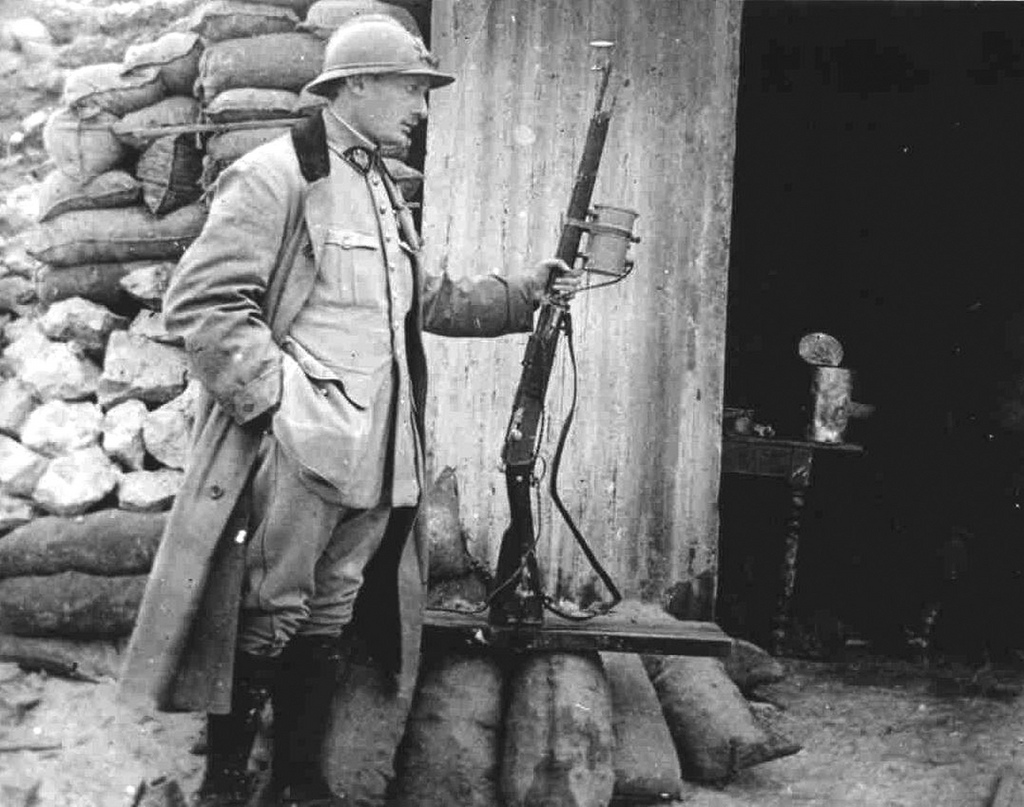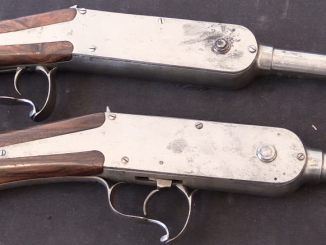
Vintage Saturday: Throw Me a Line!



By popular internet acclaim, the Worst Gun Ever is officially the Chauchat light machine gun. Every time the question comes up, that’s what people say. I’m not saying they’re necessarily wrong – but everyone always […]

The “Guycot” is a rocket ball chain rifle system named for its two creators, Paulin Gay (the designer) and Henri Guénot (the financier). They patented the idea in 1879, and manufactured it in both rifle […]

The French M1886 Lebel was the first smallbore smokeless powder rifle adopted by a major military, and was a game changer in the European arms race in the 1880s. It wasn’t an outstanding design in […]
© 2025 Forgotten Weapons.
Site developed by Cardinal Acres Web Development.

Was this for dealing with barbed wire?
Or maybe an Alpine troops thing?
I was thinking fire it into some barbed wire and pull it down from a distance
That’s certainly possible. Another thought I had was it could be a way of deploying field telephone lines to cut off groups. Fire the line then they can pull the wire on it to their position rather than someone having to crawl over no man’s land with the line.
Interesting. They actually made rifles explicitly for this purpose in the 19th century, but converting an existing rifle seems a lot more efficient (if a little lazier).
http://i.imgur.com/C2kYjU7.png
This is better than a Hollywood “grappling hook pistol” because the rifle’s mass handles recoil from throwing the cable better than a pistol would. I don’t know if this means the Lebel’s line-thrower is meant for shooting hooks or rescue lines, but I wouldn’t like to be at the receiving end. Fritz wouldn’t like getting dragged to Pierre’s place.
Interestingly, the Lyle gun, a short cannon designed to throw rescue lines to ships in distress or ship-wreck survivors stuck in the water, was produced from the late 19th century until 1952.
British SOP for clearing barbed-wire entanglements before a trench assault was initially artillery. Trouble was, it blew the wire free of its posts but didn’t cut it very effectively, resulting in an even worse obstacle for the infantry.
Next trick was throwing a grappling hook across, attached to a chain winch, and using it pull the wire up and away over an area about 20 to 30 yards wide right across the gap. The trouble with this was that the Germans tended to notice and reply with artillery, mortars, HMGs, and/or two or more of the above.
The sound of this thing going off would probably have been lost in the general drumroll of fire, especially at night. But it was unlikely to be able to launch a heavy enough line and hook to be much use in uprooting barbed wire.
It could be used to “fire” a commo wire roll, but that leads to the question of why bother? If you want commo wire laid to talk to someone doing a trench raid, the Tail-End Charlie in the raiding party carries a spool and pays it out behind him. Silently.
Similarly, if you’re using it to tap the Germans’ commo wire, that’s a two-or-three-man job with two short pieces of wire. (Splice in to his commo wire, lead the tap too one end of his barbed wire, splice your second line to the other end of the entanglement, run it back to your front line trench and hook it up.) Again, as quietly as possible.
I suppose it could be used to send a wire to a party caught in No Man’s Land, but if that’s the case, they probably have bad enough problems that a phone call probably isn’t going to be much help.
It’s definitely not a grenade launcher. Unless someone was trying to figure out how to “launch” an early home-grown jam-tin bomb of serious proportions.
Maybe it’s a front-line mouse trap?
Color me stumped.
cheers
eon
Perhaps the French thought about scaling a cliff, a castle wall, or something along those lines… as for snagging barbed wire, the poilu trying to do that might accidentally drag back a German soldier who was trying to fix the barbed wire (I’m joking, but nobody likes the idea of being dragged across no-man’s land). As for communications, there might be a chance that a spool-carrying soldier would present the opposing team with the biggest target, especially if the phone line gets tangled on something during the initial advance (to say nothing about sporadic gunfire possibly hitting the cable spool and ruining any chance of making a phone call). Phone lines were among the most numerous victims during artillery barrages, if I’m not mistaken. If the line gets cut, someone has to go fix it.
What we have to remember is how primitive by todays standards was wireless communication in the early part of the 20th century, and how easy it was to either listen in, or disrupt the other side with a shell fired from far away. Carrier pigeons were still used to tell artillery to quit hitting them, that “we are on YOUR side”!
I suspect the French officer is in some way connected to a signals unit. Note that the background is what appears to be a fairly sophisticated bunker/dugout which would be part of a “trench line”. Pretty early on the “trench line” grew into complex systems of defensive works. There were two primary communications systems within these, runners (cf. A Hitler) and wire, first using morse code, then voice. This communications wire was broken on a regular basis and had to be relaid, often under enemy fire. Launching a line several hundred feet that could then be used to pull a wire the same distance would seem like a good idea, at least to the privates who would have to cover the same distance rolling out a wire wheel.
To me it looks like a 100 year old version of a rail mounted sure fire ,and why would that stranded wire be wrapped once around the trigger?
Maybe it is not a line throwing gun. Could it be a spot light and the wire going from the device back down the stock an electric wire? Maybe there is a switch on the trigger?
Only an idiot would tie a spot light to a rifle somewhere in the trenches! It would basically shout “Here I am, SHOOT ME!!!!”
Unless there was a switch near a trigger so one could flash the light on momentarily. Not standing on top of the parapet, but maybe in a trench or behind lines to identify friend or foe in response to trench raids. Maybe if the password was not given to sentry 1, sentry 2 would flash the light, pick up the target, bang, then move. There is a brisk trade these days in lights that hang off of guns and in “tactical” flashlights meant to be used in conjunction with shooting.
At any rate, the line gun hypothesis does not make a great deal of sense either. Only use I can think of for a line gun would be to send a line to an injured person in no-man’s-land. The Germans were known to shoot at unarmed stretcher bearers.
Well, what if the line-thrower used a grappling hook? How do you scale a cliff wall without ladders?
Generally I’d agree about lights but it’s interesting to note that in The Ultimate Sniper by Major John Plaster he does briefly discuss the idea of shooting by torchlight. The really important thing emphasized is you only switch it on for a second while you take a shot then immediately switch it off before it can be used to direct aimed fire back. It’s possible someone might have tried this in the trenches. I’m only speculating though. I think it’s probably a line thrower.
Russians have similar device for AKs intended for demining stake mines:
https://www.facebook.com/photo.php?fbid=932514083474853&set=a.852542001472062.1073741830.100001488092135&type=1
That’s a fascinating set up. The reel looks like a fishing one. That device would be awesome for fishing off surf beaches.
Would this be the origin of the phrase ‘shooting a line’ when someone is telling a tall story?
Ian I was very pleased to see you on live TV ‘s Gun stories Gatling gun program was it as good as being at Red Jacket?
thats pretty cool
Michael Bane and the Gun Stories folks are not even in the same world as Sons of Guns… 🙂
Glad you liked the show! I don’t have cable TV, so I won’t be able to see the finished episodes until the whole season has aired and they send me a DVD.
Ok, everyone. I’ve copied the photo into my files and zoomed.
The “can” definitely has an electrical connection at its bottom rear. The double-stranded line from it leads to a switch on the right side of the forearm just where the fingers of the shooter’s left hand would be placed.
The wire continues back from there, past the trigger guard. Note the “loops” hanging down, which can be mistaken for a lever-action loop (which the Lebel doesn’t have). The line goes on from there, my SWAG is to a 6V battery “off-camera”, as they would say in Hollywood.
The “can” is most likely from either a French or British Aldis lamp. It’s a light, not a line canister. Note the “bolts” top and bottom; they’re the pivot trunnions for its usual mount. It’s turned 90 degrees from its usual “up and down” orientation (like cannon trunnions).
The switch on the forearm would normally be on the lamp’s mount, behind it. A message would be “tapped out” in Morse, as on a telegraph.
This rig is intended for two jobs, I suspect;
1. “Jacklighting” German soldiers trying to creep up on the position after dark. An anti trench-raid weapon.
2. “Jacklighting” rats in the trench itself.
The light going on in the target’s face would blind them, and probably “freeze” them, for a split second, just long enough for a shot.
In each case, the procedure would literally be “Flash!- BANG!”
cheers
eon
Good stuff eon! That paints a fascinating picture of what things were tried during that period!
Wow, what a sharply clothed officer! Looks more like dressed for parade.
Throwing lines was the way to connect…. hahaha, especially between ships. Now we have lot smarter links; but they are just ‘virtual’.